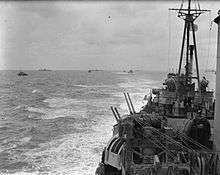HMS Mauritius (80)
 Mauritius in April 1942 | |
| History | |
|---|---|
| Name: | HMS Mauritius |
| Namesake: | Mauritius |
| Ordered: | 20 December 1937 |
| Builder: | Swan Hunter, Tyne and Wear, United Kingdom |
| Laid down: | 31 March 1938 |
| Launched: | 19 July 1939 |
| Commissioned: | 4 January 1940 |
| Fate: | Arrived at Inverkeithing to be scrapped by Thos W Ward. on 27 March 1965 |
| General characteristics | |
| Class and type: | Crown Colony-class light cruiser |
| Length: | 169.3 m (555 ft) |
| Beam: | 18.9 m (62 ft) |
| Draught: | 5 m (16 ft) |
| Propulsion: |
Four oil fired 3-drum Admiralty-type boilers, 4-shaft geared turbines, 4 screws, 54.1 megawatts (72,500 shp) |
| Speed: | 33 knots |
| Complement: | 907 |
| Armament: |
|
| Armour: |
|
| Aircraft carried: | Two Supermarine Walrus aircraft, removed 1943. |
HMS Mauritius, pennant C80, was a Crown Colony-class light cruiser of the Royal Navy. She was named after Mauritius, which was a British colony when she was built. Built by Swan Hunter, Newcastle upon Tyne, she entered service in 1941.
Service

Mauritius was completed with an internal degaussing system which induced severe corrosion to the ship's fire main (made of copper); this major defect, which rendered her unfit for action, required refits, first at Simonstown, later at Singapore, and finally at Plymouth. The future Admiral of the Fleet Henry Leach served as a midshipman aboard Mauritius during this time. She joined the Eastern Fleet in 1942, but was withdrawn in April 1943 to reinforce the Mediterranean Fleet. After repairs following grounding, she was operational in June 1943 and thereafter participated in the landings in Sicily, (Operation Husky), in July as a unit of Support Force East, when she carried out shore bombardment duties.
In September she was part of the covering force for the Salerno landings, but by the end of the year had been transferred to the Bay of Biscay to carry out anti-blockade-runner patrols, as part of Operation Stonewall. However, she soon returned to the Mediterranean, this time for the Anzio landings in January 1944. In June 1944 she covered the landings in Normandy as part of Force D off Sword Beach, then carried out offensive patrols of the Brittany coast in August to mop up the remnants of the German shipping in the area. Operating with destroyers, she sank Sperrbrecher 157 on 14/15 August and during the battle of Battle of Audierne Bay sank five Vorpostenboote on 22/23 August. After this she returned to the Home Fleet, covering the carrier raids along the Norwegian coast and making anti-shipping strikes herself. On the night of 27/28 January 1945, in company with the cruiser Diadem, she fought an action with German destroyers in which Z31 was badly damaged. Following this action she was refitted at Cammell-Laird's between February 1945 and March 1946.
She then served in the Mediterranean, including passing through the Corfu Channel in 1946, with the 15th (later lst) Cruiser Squadron, returning to the UK in 1948. After a spell in reserve and in refit, she recommissioned in 1949 for the 1st Cruiser Squadron in the Mediterranean, sailing on 6 May 1949. However, the years 1949 to 1951 were spent on the East Indies Station with the 4th Cruiser Squadron until she returned to Chatham on 18 December 1951.
Decommissioning and disposal
Mauritius was placed in reserve in 1952 and remained there until 1965, when she was sold for scrapping to Thos W Ward. She arrived at their yard at Inverkeithing, on 27 March 1965.
Shore establishment
HMS Mauritius was also the name of a Royal Navy shore establishment in Mauritius.
Notes
References
- Colledge, J. J.; Warlow, Ben (2006) [1969]. Ships of the Royal Navy: The Complete Record of all Fighting Ships of the Royal Navy (Rev. ed.). London: Chatham Publishing. ISBN 978-1-86176-281-8. OCLC 67375475.
- Raven, Alan; Roberts, John (1980). British Cruisers of World War Two. Annapolis, MD: Naval Institute Press. ISBN 0-87021-922-7.
- Rohwer, Jürgen (2005). Chronology of the War at Sea 1939-1945: The Naval History of World War Two (Third Revised ed.). Annapolis, Maryland: Naval Institute Press. ISBN 1-59114-119-2.
- Whitley, M. J. (1995). Cruisers of World War Two: An International Encyclopedia. London: Cassell. ISBN 1-86019-874-0.
- Leach, Henry (1993). Endure No Makeshifts: Some Naval Recollections. London: Leo Cooper. ISBN 1-84468-009-6.
External links
| Wikimedia Commons has media related to HMS Mauritius (80). |
